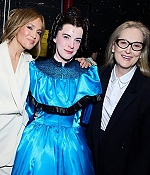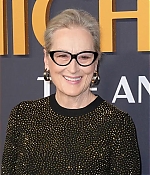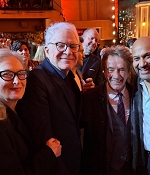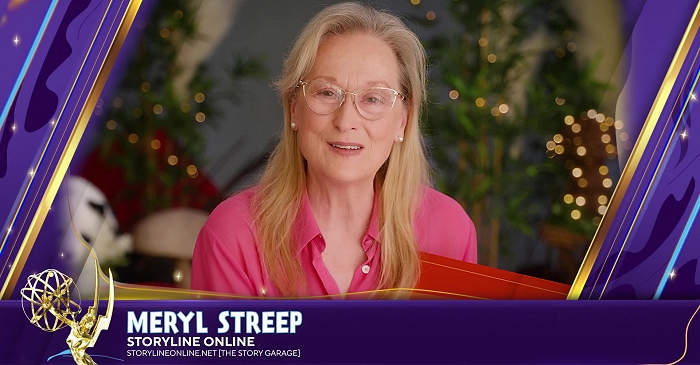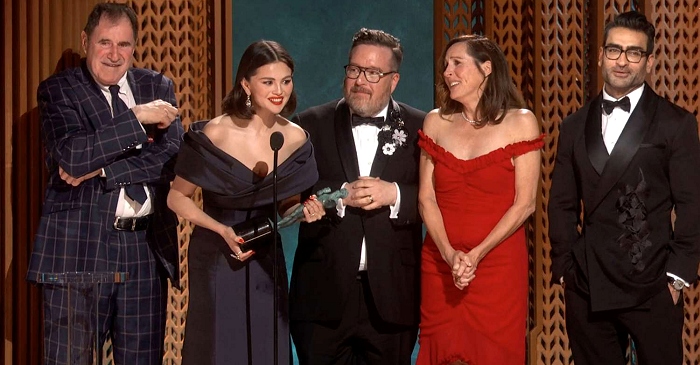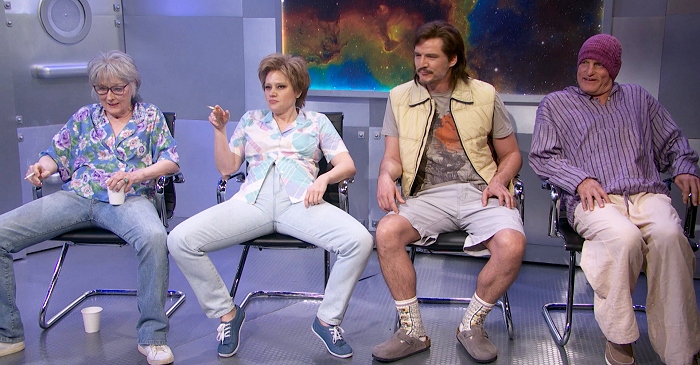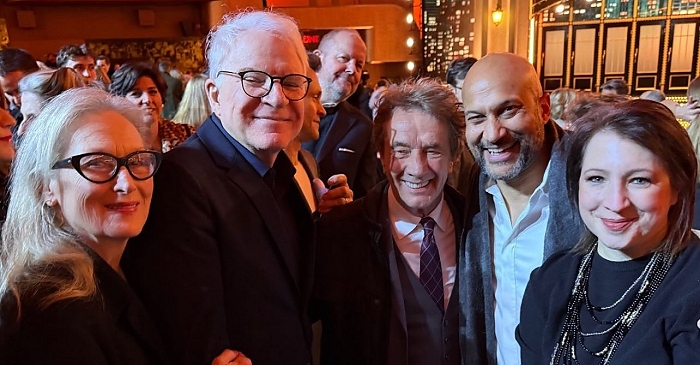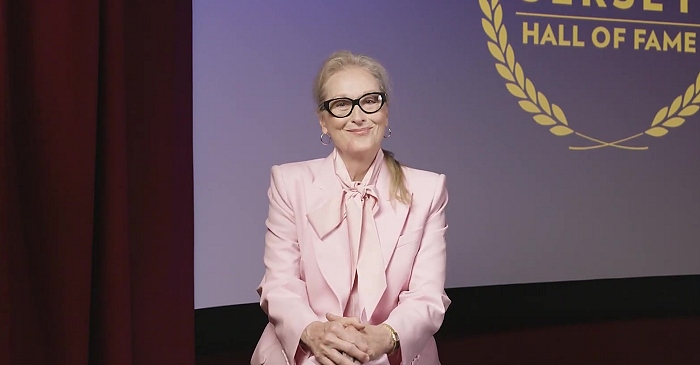|
Simply Streep is your premiere source on Meryl Streep's work on film, television and in the theatre - a career that has won her the praise to be one of the world's greatest working actresses. Created in 1999, we have built an extensive collection to discover Miss Streep's body of work through articles, photos and videos. Enjoy your stay.
|
Celebrating
25 years
of SimplyStreep
|
|
Meryl Streep and Steven Soderbergh on the ending of The Laundromat and that surprise dual role
The Los Angeles Times ·
October 25, 2019
· Written by Mark Olsen
|
One would presume that it would be hard to spoil the ending of a movie based on a book about recent real-world events, but “The Laundromat” is directed by Steven Soderbergh in a playful, predictably unpredictable fashion. So, fair warning: major spoilers ahead.
Available now on Netflix, the film is an adaptation of Jake Bernstein’s nonfiction book “Secrecy World,” which is about the 2016 Panama Papers scandal. The film tells the story of the law firm Mossack Fonseca, run by Jürgen Mossack and Ramón Fonseca Mora, played in the film by Gary Oldman and Antonio Banderas. The lawyers used all manner of technically legal, morally fuzzy financial instruments to help their clients hide their money, their identities, their true purposes or whatever it is they needed to keep secret. The film ends with Streep directly addressing the camera while saying the words of John Doe — the still-anonymous whistleblower who revealed some 11.5 million documents unveiling the work of Mossack Fonseca. Streep cycles through multiple characters and even seems to reveal herself as herself, Meryl Streep, as a way of breaking through the boundaries of the fictional world in the film while also making an earnest plea for the audience’s attention. “I liked all of that,” said Soderbergh. “It had the potential to, in front of an audience, tear down all of those tricks until there was nothing left. That seemed to me a really interesting thing to try.” “It’s a way of saying, ‘This is real. It really is happening,’” said Streep of revealing the layers of character she portrays in the movie. “And you don’t get to do that more than once. So I can’t pull it out for every movie from now on.”
Screenwriter Scott Z. Burns said that he knew early on that he wanted to use the words of John Doe at the end of the movie. “I was really impressed with it in terms of understanding the entire system,” said Burns, “and I felt that it was incumbent on me to step back and put that out there for the audience. After having taken them on this crazy ride to let them see the words of somebody who really did the heavy lifting.” In the film Streep plays Ellen Martin, a woman left widowed when her husband dies in a tour boat accident. Her attempts to get the insurance settlement, and some basic answers, leads her into a labyrinth of insurance companies, shell companies and offshore companies that eventually lands at the doorstep of Mossack Fonseca. Which is where the movie has also stepped into controversy. Partway through the story Ellen calls the offices of Mossack Fonseca in Panama and speaks on the phone with a woman named Elena. That woman is also played — here’s the spoiler — by Meryl Streep. She speaks with an accent and wears a wig, makeup and prosthetics to disguise her appearance. And yet there is a reason within the movie itself for this provocative sleight of hand. At the end of the movie, Oldman and Banderas as Mossack and Fonseca are in jail but then walk out of their cell and reveal they are on a soundstage. Elena, the Panamanian office worker, crosses their path and begins to speak, as a title card announces her words are those of John Doe.
As Elena speaks, she removes padding from her body and takes off a wig to reveal she is Ellen Martin, as Streep the actress changes her voice from one character to the other. Streep then takes off another wig and begins to brush her hair and changes her voice again to her own speaking voice. As John Doe’s words reach a crescendo, she scoops up some papers and a shawl and a hairbrush and strikes a pose as the Statue of Liberty. When “The Laundromat” had its world premiere at the Venice Film Festival and then moved on to the Toronto International Film Festival, many early reviews did not treat the second role as a spoiler, instead diving into how it impacts the movie. Writing for Vanity Fair, Richard Lawson declared the second role “a bizarre and rather galling unforced error, especially in an era of heightened consciousness about representation and appropriation. … That ugly bit makes the unpleasant suggestion that this is all just a joke for Soderbergh and crew, richies who can’t help themselves to a little non-P.C. in-crowd chuckle while — yes, yes, of course, we don’t mean to laugh — doing the good work of telling poor people how they’re being screwed.” For The Wrap, Alonso Duralde wrote, “Whatever emotional resonance Streep achieves as an angry widow is undone by the decision to cast her as a Mossack Fonseca secretary, complete with enormous fake nose and ridiculous Spanish voice.” Duralde noted of the final transformation, “It’s a jarring bit of show-offery from a performer who should be above such flash.” Writing for Remezcla, Manuel Betancourt dug even deeper, noting, “In making it so obvious at the end, and having it become a metaphor for how the system is rigged in favor of the rich, the privileged, the wealthy (yes, including celebrities like Meryl and directors like Soderbergh), the film almost begs you to nitpick and be outraged at this small bit part of brownface. But it also weaponizes it to deliver a final monologue that’s all about seeing the bigger picture. There’s a sense that Soderbergh wants us to be in on the joke (the kind where, because he’s self-aware about it means there’s little to criticize about it). But it’s all so muddled and the movie so flippant at times that it’s hard to let it go, especially when this is such a cartoonish character to begin with. There may be a point, but one wonders whether that adds up to anything at all in the end. It just feels so tone-deaf and tired and so unseemly. Even worse, so unnecessary.”
Streep said she was initially “terrified” of the monologue and that while Soderbergh had scheduled the pivotal scene for only the second day of shooting, it was pushed to the third day. “And I didn’t know what I was doing yet at all in the movie,” Streep said. “Usually directors let you get out of a car for a couple of days and walk into a building.” “I guess in my mind, what I felt was if we get that and we know we have it, we’re gold,” said Soderbergh. In an interview the day after the movie screened in Toronto, both Streep and Soderbergh expressed concerns about spoiling the surprise of the Ellen/Elena reveal. “That’s showing the shark for sure,” noted Soderbergh. Added Streep, “Listen, my maid of honor, who’s an architect here in Toronto, sat next to me at the screening last night. She had no idea. Known her for 43 years. She had no idea it was me.” At one point in the film, Banderas appears as a limousine driver for an African businessman (Nonso Anozie) living in Beverly Hills. At another point, Oldman drives a cab for an English businessman (Matthias Schoenaerts) arriving in China. This has led to some concern that Oldman is engaged in yellowface, but he is not made up in any way; while he is driving a cab in China, he is not playing a Chinese cab driver.
Soderbergh acknowledged the controversy around the dual roles for Streep but also felt that much of the initial uproar online was at that time coming from people who had not actually seen the film and so did not understand the broader storytelling reasons for which Streep plays the two roles. “The point is if you saw the film and saw the context in which this trick is being played, you would see what it’s for, what it’s in aid of,” Soderbergh said. “So it’s a difficult thing to describe to somebody in the abstract who hasn’t seen the movie and knows she has to play the part, she has to be disguised. There has to be something a little off about her. You have to do that to pay off the last shot. So I think somebody, if that was their takeaway after they saw the movie, wow, there’s a lot of stuff they didn’t see.” For her own part, Streep addressed playing the part of a Panamanian office worker: “I didn’t take a job away from a Hispanic actress,” Streep said. “I did not.” As to whether she considered any possible fallout before playing the second role, Streep said, “No.” “Oh, I did. I knew somebody would bring that up,” Soderbergh responded. “But like I said, the intention is so clear of what that’s in support of that I just went, ‘Well, that’s what the movie needs.’ Like in my mind, it has to be her.
“And it’s a comedy,” Soderbergh added. “That’s the other thing: Comedies deal in tropes like this all the time. So, yeah, I knew it would come up because that’s the culture that we’re in right now. But I also felt that it is absolutely appropriate for this piece, that it has to be done like that. And that you can draw a line between that and Gary’s impression of a German person, which maybe some German people aren’t happy with. I don’t know. But again, it’s a comedy. So to my mind, in my worldview, comedy is different, there are different rules.”
During the Q&A following the screening in Toronto, Streep was somewhat more forthcoming on the end of the movie. “In terms of directly addressing the audience, when we knew we were going to use the speech of the whistleblower John Doe at the very end of the film, it was hard because it doesn’t sound like talking, it was a letter written in this sort of thickly written language,” Streep said. “And I knew it was going to be two characters, but I thought why don’t we make it three and I’ll be me. And the Statue of Liberty. So really four characters. Only paid for one.”

